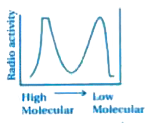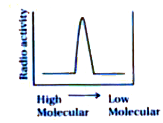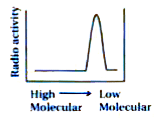Replication was allowed to take place in the presence of radioactive deoxynucleotides precursors in E.coli that was a mutant for DNA ligase. Newly synthesised radioactive DNA was purified and strands were separated by denaturation. These were centrifuged using density gradient centrifugation. Which of the following would be a correct result




The correct Answer is:D
Topper's Solved these Questions
- MOLECULAR BASIC OF INHERITANCEBOOK - KUMAR PRAKASHANCHAPTER - MOLECULAR BASIC OF INHERITANCEEXERCISE - SECTION - F (MULTIPLE CHOICE QUESTIONS (MCQs))(MCQs FROM .DARAN. BASED ON TEXTBOOK)
63 Videos
- MOLECULAR BASIC OF INHERITANCEBOOK - KUMAR PRAKASHANCHAPTER - MOLECULAR BASIC OF INHERITANCEEXERCISE - SECTION - F (MULTIPLE CHOICE QUESTIONS (MCQs))(MCQs ASKED IN COMPETITIVE EXAM)
78 Videos
- MOLECULAR BASIC OF INHERITANCEBOOK - KUMAR PRAKASHANCHAPTER - MOLECULAR BASIC OF INHERITANCEEXERCISE - SECTION - E (SOLUTION OF NCERT EXEMPLAR)(SHORT ANSWER TYPE QUESTIONS)
23 Videos
- MODEL QUESTION PAPER FOR ANNUAL EXAMBOOK - KUMAR PRAKASHANCHAPTER - MODEL QUESTION PAPER FOR ANNUAL EXAMEXERCISE - Part- B ( Section C)
4 Videos
- ORGANISMS AND POPULATIONSBOOK - KUMAR PRAKASHANCHAPTER - ORGANISMS AND POPULATIONSEXERCISE - SECTION - F (MULTIPLE CHOICE QUESTIONS)(MCQs ASKED IN COMPETITIVE EXAM)
103 Videos
Similar Questions
Replication was allowed to take place in the presence of redioactive deoxynucleotides precursors in E. coli that was a mutant for DNA ligase. Nswly synthesised redioactive DNA was purified and strands were separated by denatureation. These were centrifuged using density gradient centrifugation. Which of the following would be a correct resulat ?

View SolutionReplication was allowed to take place in the presence of redioactive deoxynucleotides precursors in E. coli that was a mutant for DNA ligase. Nswly synthesised redioactive DNA was purified and strands were separated by denatureation. These were centrifuged using density gradient centrifugation. Which of the following would be a correct resulat ?

View Solution
Knowledge Check
E. coli about to replicate was placed in a medium containing radioactive thymidine for five minutes. Then it was made to replicate in a normal medium. Which of the following observation will be correct ?
ABoth the strands of DNA will be radioactiveBEach strand half radioactiveCOne strand radioactiveDNone is radioactiveE. coli about to replicate was placed in a medium containing radioactive thymidine for five minutes . Then it was made to replicate in a noemal medium . Which of the following obervation shall be correct ?
ABoth the strands of DNA will be radioactiveBOne strand radioactiveCEach strand half radioactiveDNone is radioactiveRead the passage carefully and answer the question given below:
You might not think of plants as particularly chatty but in reality, they communicate surprisingly well with each other, especially when faced with danger. According to a recent study in the journal Frontiers in Plant Science injured plants send out emergency signals to alert neighbors to start building up their defenses.
The chain of events that led to this surprising discovery began about two years ago, after University of Delaware botanist Harsh Bais agreed to mentor 16-year-old Connor Sweeney on a research project. The ecstatic high school student got to work right away, spending all his free time, including weekends and summer breaks, in Bais's lab at the Delaware Biotechnology Institute.
His project entailed culturing Arabidopsis thaliana, also known as mustard weed, for use in experiments. The young researcher would place the seeds in Petri dishes and test tubes filled with agar to promote growth. The seeds would germinate about six days later and transform into delicate three-inch saplings with bright green leaves.
One day, Sweeney sliced a mustard weed leaf in two spots mimicking an insect bite to see how it would begin the repair process. The following day, the young researcher was surprised to find that while the injured plant remained unchanged, the roots of the neighboring young mustard weed sapling had grown considerably longer and even had lateral offshoots.
“It was crazy — I didn't believe it at first. I would have expected the injured plant to put more resources into growing roots. But we didn't see that.” said Bais, who conducted a similar study in 2012, where he found that soil bacteria living near the roots of a plant helped boost its immunity by signaling the leaf pores, or stomata, to close in the presence of pathogens. To ensure that it was not the same system at work, Sweeney partitioned the plants to prevent any communication between their root bacteria and repeated the experiment multiple times. The results were he same!
www.dogonews
Question: Which of the following options does not mean the underlined word ‘ecstatic’ in Paragraph 2?AThrilledBOverjoyedCDoubtfulDExcited
The semi-conservative nature of DNA replication was established by Meselson and Stahl in their classic experiment with bacteria. They grew bacteria in N15−NH4CI containing medium with N14 - containing compounds and allowed to grow for three generation . CsCI density gradient centrifugation of isolated DNA established the nature of semiconservation DNA replication. The pictorial representation below shows the positon of differentially labeled DNA in CsCI density gradient.

Had the DNA replication been conservative, what would have been the pattern ?
View SolutionThe semi-conservative nature of DNA replication was established by Meselson and Stahl in their classic experiment with bacteria. They grew bacteria in N15−NH4CI containing medium with N14 - containing compounds and allowed to grow for three generation . CsCI density gradient centrifugation of isolated DNA established the nature of semiconservation DNA replication. The pictorial representation below shows the positon of differentially labeled DNA in CsCI density gradient.

Had the DNA replication been conservative, what would have been the pattern ?
View SolutionThe proof for semiconservative mode of DNA replication was First provided by Matthew Meselson and Franklin Stahl. Escherichia coli were the first organism to be used for this experiment and then it was done in with higher organisms such as plants and human cells. The process of DNA replication in terms of energy is a very expensive process. It involves the formation of a replication fork. Given below is a graph showing the percentage of Adenine in two different double stranded DNA.
Which among the following is the appropriate reason for Primase being the primary enzyme responsible for initiation of DNA synthesis?
View SolutionComprehension:
Read the passage and answer the questions that follow.
The methods of embalming, or treating the dead body, that the ancient Egyptians used is called 'mummification'. Using special processes, the Egyptians removed all moisture from the body, leaving only a dried form that would not easily decay. It was important in their religion to preserve the dead body in as life like a manner as possible. The mummification process took seventy days. Special priests worked as embalmers, treating and wrapping the body. Beyond knowing the correct rituals and prayers to be performed at various stages, the priests also needed a detailed knowledge of human anatomy. The first step in the process was the removal of all internal parts that might decay rapidly. The brain was removed by carefully inserting special hooked instruments up through the nostrils in order to pull out bits of brain tissue. The embalmers then removed the organs of the abdomen and chest through a cut usually made on the left side of the abdomen. They left only the heart in place, believing it to be the center of a person's being and intelligence, The other organs were preserved separately, with the stomach, liver, lungs and intestines placed in special boxes or jars, today called 'canopic jars'. These were buried with the mummy. The embalmers next removed all moisture from the body. This they did by covering the body with 'natron, a type of salt which has great drying properties, and by placing additional natron packets inside the body. When the body had dried out completely, embalmers removed the internal packets and lightly washed the natron off the body. The result was a very dried-out but recognizable human form. To make the mummy seem even more life like, sunken areas of the body were filled out with linen and other materials and false eyes were added. Next the wrapping began. Each mummy needed hundreds of yards of linen. The priests carefully wound the long strips of linen around the body, sometimes even wrapping each finger and toe separately before wrapping the entire hand or foot. In order to protect the dead from mishap in after life, amulets were placed among the wrappings and prayers and magical words written on some of the linen strips. Often the priests placed a mask of the person's face between the layers of head bandages. At last the priests wrapped the final cloth or shroud in place and secured it with linen strips. The mummy was complete. It was then placed in the tomb along with food, furniture, vessels, perfumes, jewels and other things required in the afterlife.
SubQuestion No : 34
Which of the following was NOT buried with the mummies?
View SolutionThe great fear in Asia a short whi l.e ago was that the region would suffer through the wealth destruction already taking place in the U.S as a result of the financial crisis. Stock markets tumbled as exports plunged and economic growth deteriorated. Lofty property prices in China and elsewhere looked set to bust as credit tightened and buyers evaporated. But with surprising speed, fear in Asia swung back to greed as the region shows signs of recovery and property and stock prices are soaring in many parts of Asia.
Why should this sharp Asian turnaround be greeted with skepticism? Higher asset prices mean households feel wealthier and better able to spend, which could further fuel the region's nascent rebound. But just as easily, Asia could soon find itself saddled with overheated markets similar to the U.S. housing market. In short, the world has not changed, it has just moved placed.
The incipient bubble is being created by government policy. In response to the global credit crunch of 2008. Policy makers in Asilt slashed interest rates and flooded financial sectors with cash in frantic attempts to keep loans flowing and economies growing. Thesf steps were logical for central bankers striving to reverse. a deepening economic crisis. But there is evidence that there is too much easy money around. It's winding up in stocks and real estate, pushing prices up too far and too fast for the undenying economic fundamentals. Much of the concern is focused on China where government stimulus efforts have been large and effective, Money ir China has been especially easy to find. Aggregete new bank lending surged 201 % in first half of 2009 from the same period a yea earlier, to nearly 51 .1 turn on. Exuberance over a quick recovery which was given a boost by China's surprisingly strong 7 .9% GDI growth in the second quarter has buoyed investor sentiment not just for stocks but also for real estate.
Former U.S. Federal Reserve Chairman Alan Greenspan argued that bubbles could only be recognised in hand sight. But investor who have been well schooled in the dangers of bubbles over the past decade are increasingly wary that prices have. risen too far ant that the slightest bit of negative, economic news could knock markets for a loop. These fears are compounded by the possibility that Asia's central bankers will begin taking stops to shut off the mnoney. Rumours that Beijing was on the verge of tightening cred led to Shanghai stocks plunging 5%. Yet many economists believe that, there is close to· a zero possibility.that the Chines government will do anything this year that constitutes tightening. And without a major shift in thinking, the easy-money condition will stay in place. In a global economy that has produced more dramatic ups and downs than anyone thought possible over the pas two years. Asia may be neading for another disheartening plunge.
What does the author want to convey through the phrase "The world has not changed it has just moved places"?
View Solution
